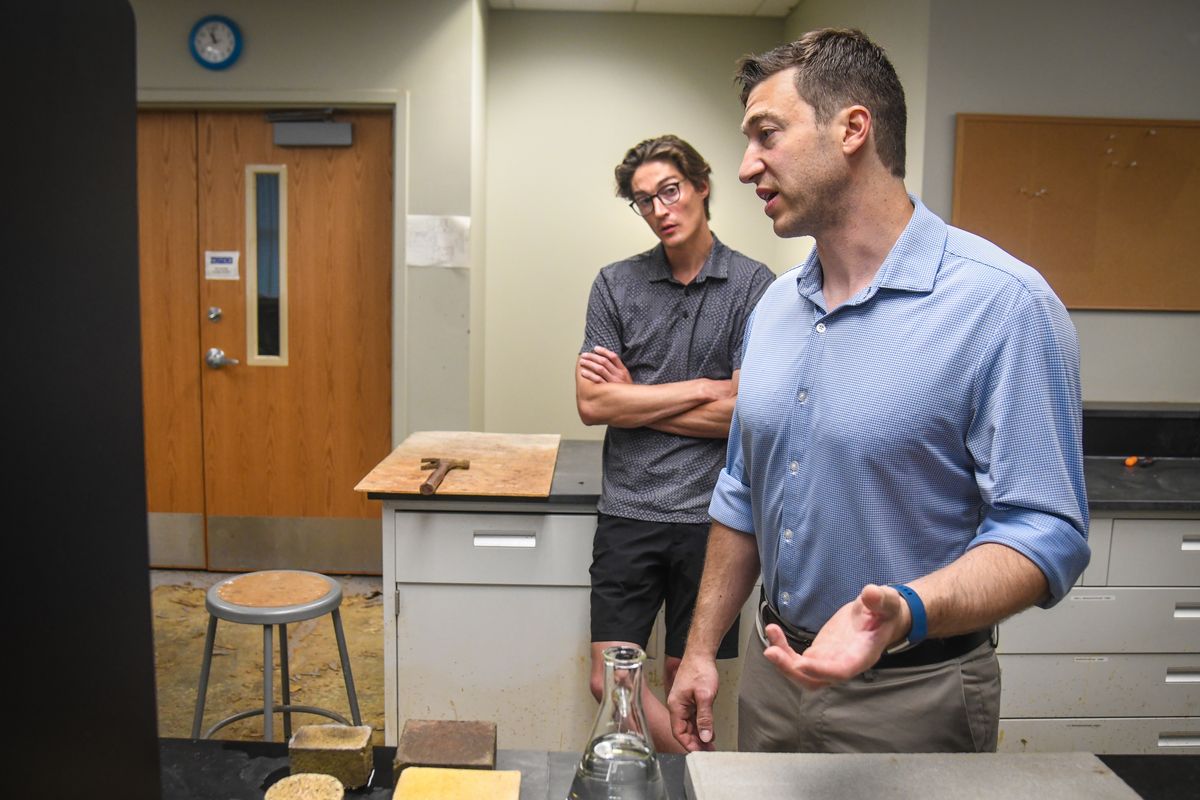Spokane company seeks aid manufacturing water filtrating building material

Two Spokane-based entrepreneurs think they’ve found the “secret sauce” to make a new type of water-filtration building material to line the streets of major U.S. cities.
“We just kind of saw this huge glaring need in the market that was not being addressed,” said Greg Johnson, founder and chief executive officer of a company called Aquipor. The firm has patents pending for a new formula of pervious building material that is capable of filtering pollutants from rainfall runoff before that water hits the sewer system.
It’s the continuation of an effort that started nearly a decade ago for Johnson and Kevin Kunz, a Washington State University graduate who was introduced to the idea of permeable pavement while completing his studies. Kunz received a Chinese-manufactured clay brick from a friend that used pores in its design to let water flow freely through the material, filtering out pollutants both natural and man-made before the rainfall seeped back into the ground.
“I put that under the faucet, and I was blown away,” said Kunz. “It was like a magic trick.”
When rainwater hits traditional building material, like concrete, it pools, eventually running into a drain that in many cities sweeps it away to a treatment plant. When it hits the material Johnson and Kunz have designed and demonstrated last week at their lab space in Post Falls, the water instead seeps into the material, disappearing as though it had been soaked up by a sponge. Pollutants would remain on the surface of the material, ready to be cleared away by normal street sweeping activities, they said.
The pair are now seeking $1 million in a crowdfunded equity effort to scale up their production of the material, and seek a licensing agreement with local precasting companies that could produce their building material recipe on a larger scale for use by municipal governments and private builders.
Johnson said the goal is to demonstrate Aquipor’s capabilities in Spokane, where the material was invented. The first prototypes were baked in a kiln on the campus of Gonzaga University, he said. It’s also a city that has its own unique challenges with stormwater runoff, investing tens of millions of dollars in subterranean storage tanks and upgraded filtration treatment at the Riverside Water Reclamation Facility to improve the quality of water pumped back into the Spokane River.
“Those tanks do a tremendous job of solving the majority of the problem,” Kunz said. “But they weren’t designed for these storms that are coming now.”
Evidence of the need for additional measures to reduce the strain on the city’s tank system can be seen in the flooding that inundated Spokane’s streets in May 2019, Johnson and Kunz said. Though much of that flooding was confined to areas where tanks had not been connected to the city’s stormwater drains, areas that had been connected saw discharges of untreated water directly into the Spokane River when the pipes became overwhelmed by what city officials called an abnormal storm.
That’s a problem for a city that’s trying to meet water quality standards imposed by regulators at the federal and state level, standards that limit the number of times the combined sewer system overflows directly into the river. Spokane has already experimented with pervious pavement on Sharp Avenue near Gonzaga University and the bike lanes on Havana Street, said Marlene Feist, director of strategic development for the city’s Public Works division.
“I think we like the concept,” Feist said, noting that use of the material requires frequent street cleaning to ensure filtration isn’t inhibited.
The limitations on direct discharges into the Spokane River are driven in part by a desire to reduce the amount of polychlorinated biphenyls, or PCBs, that make their way into the water system. Banned from products in the 1970s, PCBs are known to cause cancer, and their acceptable levels in the waterways in Spokane and across the state has been the source of ongoing controversy among businesses, governments and conservation groups.
The Aquipor product would work in theory to filter PCBs because the chemicals are attracted to solids, but definitive testing is planned in the future, Johnson said.
Jerry White Jr., Spokane Riverkeeper, said the organization is supportive of the technology being developed by Aquipor. It could have applications not only in areas where stormwater drains are connected to the sewer, including the South Hill and downtown, but also in north Spokane in what is known as the Cochran Basin, where stormwater runoff is diverted from sewers and flows directly into the river.
“This direction they’re going is really positive,” White said. “I think it’s really the future of intervening on behalf of our waterways to stop pollution.”
Aquipor, an amalgam of the aquifer that provides Spokane with drinking water and porous material, has until the end of August to meet its equity goal of $1 million.
As of Friday, the company had raised a little more than $111,000 on the platform StartEngine .